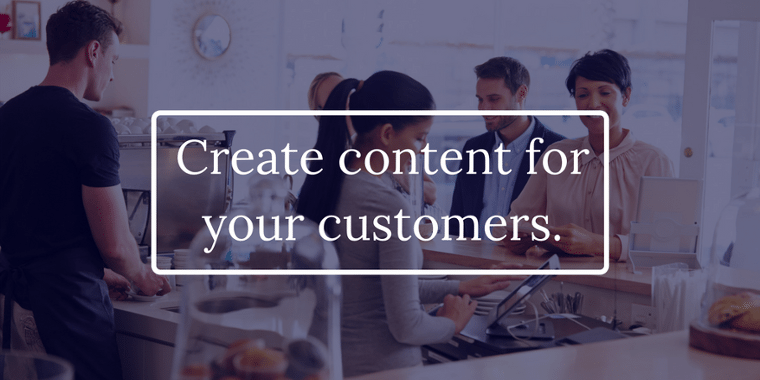Small business owners are well aware that they and their employees wear many hats. Being part of a small business provides a lot of learning opportunities and growth not found in the corporate world. Part of forging the path for your small business involves learning how to market your business in the most cost efficient and most effective way possible with limited capital and human resources.

You’ve done your fair share of research. You understand the importance of a good website with valuable information, interacting on social media platforms, and producing content that your customers want to read. You may have come across the name inbound marketing; you know it is a great concept and it is near the top of your wishlist for your business.
You can hire a marketing agency or professional to grow your business, but even if you can’t afford to take that route immediately, there are steps you can take to start implementing the inbound marketing methodology on your own.
We are creatures of habit. In order to avoid falling back into old marketing habits, we need to consistently hold ourselves to a higher standard. Let’s take a look at a few principles that are necessary in the beginning stages of inbound marketing strategy implementation.
No. 1 Understand Your Customer Beyond Their Demographics
According to a 2014 study of U.S. consumers, 40% surveyed felt that companies miss meeting customer expectations. Only 5% said that companies were surpassing customer expectations. This statistic alone shows that there is a large disconnect between a business, their customers, and the perception of surpassing expectations.

This clearly shows that the level of understanding by the company in regards to their customer plays a large role in this disconnect. More than likely, the company does have an idea of their buyer. They know their age, basic demographics, where they go online to consume information, etc., but something is missing.
Jason Friedman, founder of the CXFormula, states: “The customer experience only happens on the customer side; in fact, it happens inside the customer.” He then says, “The good news is, you can design and engineer the journey that customers go on with you, to help ensure they feel great and invest in a relationship with you and your brand. If you do it right, they’ll tell everyone exactly what you want them to.”
What many companies lack is a deep understanding of their buyer which enables them to design and engineer a rich and ongoing content strategy that will enhance the user experience and meet their buyers’ expectations.
Understanding the buyer at a deeper level can be gained by answering the following questions:
- What is their learning style?
- What are some of their key traits: proactive, practical, hardworking?
- What brands do they identify with or have a relationship with? (e.g. Apple, Facebook, etc.)
- What motivates them to engage with your business?
- What are their most important goals (as they relate to your business)?
When you make the choice to not settle for a shallow perception of your customer, you also make the conscious choice to do what it will take to have a deep understanding of your buyer. This will result in a more effective implementation of a strategy that focuses on and meets the needs of your client.
No. 2 Communicate Your Message Without Referring To Yourself
We all have had a friend that we have shared our troubles and concerns with. They give their best effort to help by sharing their own stories and offering solutions based on their experiences. Their genuine efforts to help don’t always help. That doesn’t mean they don’t have your best interests at heart. They just communicated incorrectly. They could have taken the same ideas and used different words to show that they genuinely care.

So it is with inbound marketing. How you communicate your message through client-centered content matters. Here are three steps to follow when creating client-centered content:
Step 1: Answer the question, “What is my goal?”
- I want to increase my client base by communicating to my audience that we offer consulting services to companies that help them to become more effective and efficient in communication and work productivity. I have an ebook that has identified 3 areas that would help them and I want to achieve ‘x’ downloads and generate ‘y’ leads.
Step 2: Transform your goals and use language that shows what you can do to help.
- We have proven experience in consulting with companies that are experiencing low productivity, low morale, and high employee turnover rates by identifying areas in the company culture and providing solutions. We’ve identified 3 areas for you to examine to see if you need a change in your company’s culture.
Step 3: Change the information in the above statement and leave out all forms of ‘me’ or ‘we’ or ‘I’; address the customer with what matters to them and offer them help.
- A healthy business culture is vital to the success of your company. The roots of low productivity and performance are found within the culture of your business. Here are three areas to examine when deciding if you need a change in company culture: (Then offer (in the form of a blog, an ebook, a video, etc.) the 3 areas of their company your potential client can look at when determining if they need a change in company culture.)
No. 3 Use the 80:20 Principle As a Guideline
The 80:20 rule (AKA the Pareto Principle) is fairly common in the business world.
The 80:20 principle, when applied to digital marketing, means 80% of your social media posts, content, and website information need to be formatted so that they address the needs of your customer and provide a superior customer experience. Twenty percent of your content can talk about your company. When you apply this to your buyer’s journey, you will find that the 80% falls into the first phases of the funnel and then is intermixed with the 20% in the final stages of the buyer’s journey.
When following this rule, remember that it is a guideline, not a law of the universe. You may have a business that would benefit from a different ratio of client-centered to promotional content. Test it out and see what works best with your business.
Seeing Your Client Through New Lenses
Learning to look and communicate through the lens of your client is not something that happens overnight. It will take practice, determination, and self-discipline, but the rewards will pay off exponentially as you deliver a superior customer experience through each interaction with your customer.
Don’t lose sight of what you have to offer your current and potential customers. You are in business for a reason. There is something about what you have to offer that adds value to your customer’s lives. It’s only a matter of what and how you communicate as to whether or not they will look further into your business as a source for their needs.
As you keep your customers’ needs in mind, it will greatly reduce the stress of being reactive as these shifts make way for more proactive decisions. Customer-centric thinking does more than increase the bottom line, it provides employers and employees the opportunity to think beyond themselves and create a more purposeful experience.
